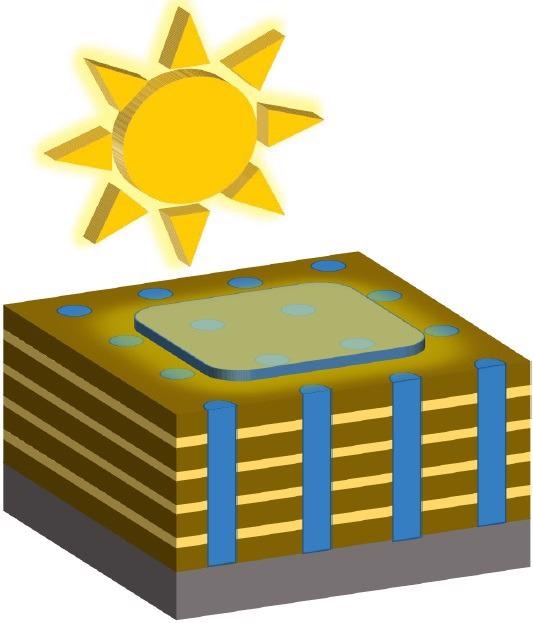Feb 3 2021
A new technique to develop unique solar cells could considerably enhance their efficiency. Apart from being made of thin layers, the cells also include nanoblocks that are specifically arranged.
 This schematic representation shows the new structure: nickel oxide stripes run perpendicular to the actual material, serving as a passing lane for the electrons. Image Credit: Lutz Mühlenbein.
This schematic representation shows the new structure: nickel oxide stripes run perpendicular to the actual material, serving as a passing lane for the electrons. Image Credit: Lutz Mühlenbein.
This has been demonstrated by an international team of researchers led by the Martin Luther University Halle-Wittenberg (MLU), in a new study published in Nano Letters, a scientific journal.
Solar cells available in the market are chiefly made of silicon. “Based on the properties of silicon it’s not feasible to say that their efficiency can be increased indefinitely,” stated Dr Akash Bhatnagar, a physicist from the Centre for Innovation Competence (ZIK) 'SiLi-nano' at MLU.
This, his team of researchers has been analyzing what is called the anomalous photovoltaic effect that occurs in specific materials. This effect does not need a p-n junction, which otherwise allows current flow in silicon solar cells.
The asymmetric crystal structure of the corresponding materials governs the direction of the current at the atomic level.
These materials are generally oxides with certain vital benefits—they are easier to produce and much more durable. But they usually do not absorb more sunlight and exhibit a very high electrical resistance.
In order to utilise these materials and their effect, creative cell architectures are needed that reinforce the advantages and compensate for the disadvantages.
Lutz Mühlenbein, Study Lead Author, Martin Luther University Halle-Wittenberg
As part of their new study, the physicists proposed an innovative cell architecture—what is called a nanocomposite. Research teams from the Bergakademie Freiberg, the Leibniz Institute of Surface Modification in Leipzig, and Banaras Hindu University in India also contributed to the study.
The researchers performed the experiment by stacking single layers of a standard material with a thickness of just a few nanometers on top of one another and offset them with nickel oxide strips that run perpendicularly.
The strips act as a fast lane for the electrons that are generated when sunlight is converted into electricity and which are meant to reach the electrode in the solar cell.
Akash Bhatnagar, Physicist, Centre for Innovation Competence, Martin Luther University Halle-Wittenberg
This is exactly the transport, which would otherwise be inhibited by the electrons that must traverse each individual horizontal layer. In fact, the new architecture enhanced the electrical output of the cell by a factor of five. An added benefit of the new technique is that it can be implemented very easily.
The material forms this desired structure on its own. No extreme external conditions are needed to force it into this state.
Lutz Mühlenbein, Study Lead Author, Martin Luther University Halle-Wittenberg
The researchers have now offered an initial feasibility study for the concept, which could even be applied to materials apart from nickel oxide. Follow-up studies must now analyze whether and how solar cells such as these can be manufactured on an industrial scale.
The research was financially supported by the Deutsche Forschungsgemeinschaft (DFG, German Research Foundation), the Federal Ministry of Education and Research (BMBF), and with grants from the European Regional Development Fund (ERDF).
Journal Reference:
Mühlenbein, L., et al. (2021) Nanocomposites with Three-Dimensional Architecture and Impact on Photovoltaic Effect. Nano Letters. doi.org/10.1021/acs.nanolett.0c03654.